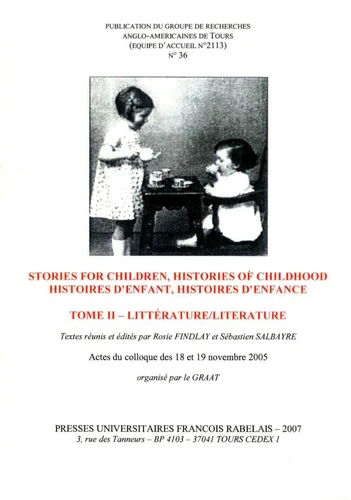GRAAT N° 36, Juin 2007
Histoires d'enfant, histoires d'enfance. Tome 2, Littérature
Par : , Formats :
Disponible dans votre compte client Decitre ou Furet du Nord dès validation de votre commande. Le format Multi-format est :
- Pour les liseuses autres que Vivlio, vous devez utiliser le logiciel Adobe Digital Edition. Non compatible avec la lecture sur les liseuses Kindle, Remarkable et Sony
 , qui est-ce ?
, qui est-ce ?Notre partenaire de plateforme de lecture numérique où vous retrouverez l'ensemble de vos ebooks gratuitement
Pour en savoir plus sur nos ebooks, consultez notre aide en ligne ici
- Nombre de pages423
- FormatMulti-format
- ISBN978-2-86906-483-6
- EAN9782869064836
- Date de parution01/06/2017
- Protection num.NC
- Infos supplémentairesMulti-format incluant PDF avec W...
- ÉditeurPresses universitaires François-...
Résumé
The place of the child and childhood in our culture and his/her legal status is a subject which touches a sensitive nerve and triggers passionate responses just as much at the start of the 21st century as it did two hundred years ago. Curious then to note that the academic study of childhood had long been neglected by social historians while its literature, with a few notable exceptions, had too often been relegated to a minor category when not simply dismissed as "pulp fiction".
Over the last two decades or so pioneering research has begun to redress this balance and paved the way towards a reappraisal of the child and childhood as a valid field of study. At the same time, by highlighting the areas which still require exploration, it has underlined the distance we still have to cover in order to achieve a balanced integration of both the child and childhood into the social and cultural "story" of our past.
It is hoped that the papers published here will, in their own modest way, contribute to this ongoing process of replacing the child inside a culture which proudly claims to have created the golden age of childhood.
Over the last two decades or so pioneering research has begun to redress this balance and paved the way towards a reappraisal of the child and childhood as a valid field of study. At the same time, by highlighting the areas which still require exploration, it has underlined the distance we still have to cover in order to achieve a balanced integration of both the child and childhood into the social and cultural "story" of our past.
It is hoped that the papers published here will, in their own modest way, contribute to this ongoing process of replacing the child inside a culture which proudly claims to have created the golden age of childhood.
The place of the child and childhood in our culture and his/her legal status is a subject which touches a sensitive nerve and triggers passionate responses just as much at the start of the 21st century as it did two hundred years ago. Curious then to note that the academic study of childhood had long been neglected by social historians while its literature, with a few notable exceptions, had too often been relegated to a minor category when not simply dismissed as "pulp fiction".
Over the last two decades or so pioneering research has begun to redress this balance and paved the way towards a reappraisal of the child and childhood as a valid field of study. At the same time, by highlighting the areas which still require exploration, it has underlined the distance we still have to cover in order to achieve a balanced integration of both the child and childhood into the social and cultural "story" of our past.
It is hoped that the papers published here will, in their own modest way, contribute to this ongoing process of replacing the child inside a culture which proudly claims to have created the golden age of childhood.
Over the last two decades or so pioneering research has begun to redress this balance and paved the way towards a reappraisal of the child and childhood as a valid field of study. At the same time, by highlighting the areas which still require exploration, it has underlined the distance we still have to cover in order to achieve a balanced integration of both the child and childhood into the social and cultural "story" of our past.
It is hoped that the papers published here will, in their own modest way, contribute to this ongoing process of replacing the child inside a culture which proudly claims to have created the golden age of childhood.



